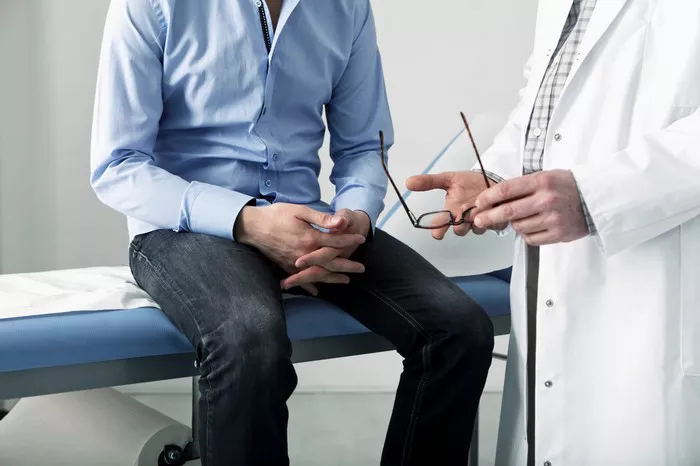Varicocele is a condition characterized by the enlargement and dilation of the veins within the pampiniform plexus in the scrotum. It is a relatively prevalent issue, especially in adolescent and adult males. The testicular veins, which are responsible for draining blood from the testicles, develop an abnormal flow pattern in varicocele. This often leads to a pooling of blood, which can have adverse effects on testicular function.
The importance of treating varicocele lies in its potential to impact male fertility and hormonal balance. The abnormal venous congestion can cause an increase in testicular temperature, disrupt the supply of oxygen and nutrients to the testes, and potentially affect sperm production and testosterone synthesis. Understanding the treatability of varicocele is crucial for men who may be experiencing symptoms or concerned about their reproductive health.
Diagnosis of Varicocele
Physical Examination: A doctor typically starts the diagnostic process with a physical examination of the scrotum. When the patient is standing, the doctor may palpate the scrotum to feel for the presence of enlarged and tortuous veins, which often feel like a “bag of worms.” Coughing or performing a Valsalva maneuver (straining as if to have a bowel movement) can sometimes make the varicocele more prominent and easier to detect. However, physical examination alone may not be sufficient to accurately assess the severity and extent of the varicocele.
Ultrasound Imaging: Ultrasound is the most commonly used and reliable method for diagnosing varicoceles. It allows for a detailed visualization of the testicular veins, enabling the doctor to measure the size of the varicocele, assess the blood flow within the veins, and determine the number and location of the affected veins. Doppler ultrasound, in particular, can provide valuable information about the direction and velocity of blood flow, which helps in grading the varicocele. For example, a grade I varicocele may show only minimal dilation and slow retrograde flow, while a grade III varicocele is characterized by significant dilation and rapid retrograde flow.
Surgical Treatment Options
Open Varicocelectomy: This is a traditional surgical approach where an incision is made in the scrotum or the lower abdomen to access the affected veins. The surgeon then ligates (ties off) or excises the abnormal veins, allowing for the restoration of normal venous drainage. One advantage of this method is that it has a relatively long history of successful use. However, it may carry a higher risk of complications such as damage to the testicular artery or lymphatic vessels, which could potentially affect testicular function and lead to swelling or other post-operative issues.
Laparoscopic Varicocelectomy: This minimally invasive technique uses a laparoscope, a thin tube with a camera and surgical instruments attached. Small incisions are made in the abdomen, and the surgeon operates through these ports. It offers the benefits of a shorter hospital stay, less post-operative pain, and a faster recovery time compared to open surgery. But it requires specialized training and equipment, and there is still a small risk of injury to surrounding structures. For instance, if the surgeon is not highly experienced, there could be accidental damage to the bowel or other abdominal organs during the procedure.
Microsurgical Varicocelectomy: As the name suggests, this procedure is performed under a microscope, which allows for a more precise identification and preservation of the testicular artery and lymphatic vessels while ligating the abnormal veins. It has a high success rate in terms of improving testicular function and fertility outcomes. The risk of complications is relatively low, but it demands a high level of surgical skill and expertise. The surgeon must have extensive training in microsurgery to be able to perform this technique accurately.
Non-Surgical Treatment Options
Scrotal Support: Wearing a scrotal support or an athletic supporter can provide some relief from the discomfort and pain associated with varicocele. It helps to elevate the scrotum, which can reduce the pooling of blood and ease the pressure on the veins. However, it does not address the underlying cause of the varicocele and is mainly a symptomatic treatment. It is often recommended for mild cases or as a complementary measure while waiting for a more definitive treatment or in cases where surgery is not an option.
Lifestyle Modifications: Making certain lifestyle changes can also potentially help manage varicocele symptoms. These include avoiding prolonged standing or sitting, as both can increase the pressure in the scrotum and exacerbate the varicocele. Regular exercise, especially activities that promote good blood circulation like walking or swimming, may be beneficial. Additionally, maintaining a healthy weight is important, as obesity can put extra pressure on the abdominal veins and contribute to the development or worsening of varicoceles. But again, these lifestyle modifications alone are unlikely to completely cure the varicocele.
Benefits and Risks of Treatment
Benefits of Treatment: The primary benefit of treating varicocele is the potential improvement in male fertility. By restoring normal venous drainage and reducing the abnormal testicular environment, sperm production and quality may increase. For example, studies have shown that after successful varicocele treatment, there can be an increase in sperm count, motility, and normal morphology. Treatment can also help correct any hormonal imbalances, such as low testosterone levels, which can have a positive impact on sexual function, energy levels, and overall well-being. In some cases, it may also relieve the pain and discomfort associated with varicoceles, improving the patient’s quality of life.
Risks of Treatment: Each treatment option comes with its own set of risks. In surgical procedures, as mentioned earlier, there is a risk of damage to the testicular artery, which could lead to testicular atrophy or loss of function. Lymphatic vessel damage can result in scrotal lymphedema or swelling. There is also a risk of infection, bleeding, and recurrence of the varicocele. Non-surgical treatments, while generally less risky, may not provide a complete solution. For example, relying solely on scrotal support or lifestyle changes may not prevent the varicocele from progressing and causing further damage to testicular function over time.
Post-Treatment Care and Follow-Up
Immediate Post-Operative Care: After surgical treatment, patients require careful monitoring. This includes pain management, usually with prescribed pain medications. The surgical site needs to be kept clean and dry to prevent infection. The patient may be advised to limit physical activity for a certain period, typically a few days to a couple of weeks, depending on the type of surgery. For example, after open varicocelectomy, the recovery time may be longer compared to laparoscopic or microsurgical procedures.
Long-Term Follow-Up: Long-term follow-up is essential to assess the effectiveness of the treatment. This involves regular semen analysis to monitor sperm parameters and determine if there has been an improvement in fertility. Hormonal levels, such as testosterone, may also be checked. Physical examinations are performed to check for any signs of recurrence or complications. The frequency of follow-up visits may decrease over time but usually continues for at least a year or more. For instance, in the first few months after treatment, the patient may have a follow-up visit every 3 months, and then it may be spaced out to every 6 months or annually.
Impact on Fertility and Quality of Life
Fertility Improvement: Successful treatment of varicocele can have a significant positive impact on male fertility. As the testicular environment normalizes, the chances of natural conception increase. Couples who have been struggling with infertility due to the male partner’s varicocele may see an improvement in their ability to conceive. However, it is important to note that the extent of fertility improvement can vary from person to person, and in some cases, additional fertility treatments may still be required.
Quality of Life Enhancement: Treating varicocele can also enhance the patient’s quality of life. Relief from pain and discomfort in the scrotum allows for a more active and comfortable lifestyle. Improvement in hormonal balance can lead to increased energy, better mood, and improved sexual function. This can have a positive impact on the patient’s self-esteem and relationships, both personally and sexually.
Conclusion
In conclusion, varicocele is a treatable condition. There are several treatment options available, each with its own benefits and risks. The choice of treatment depends on various factors such as the severity of the varicocele, the patient’s symptoms, and their desire for fertility improvement. With proper diagnosis, treatment, and follow-up, men with varicocele can have a good chance of improving their testicular function, fertility, and overall quality of life. However, ongoing research is still needed to further optimize treatment strategies and improve outcomes for patients with this common condition.
Related topics:


























